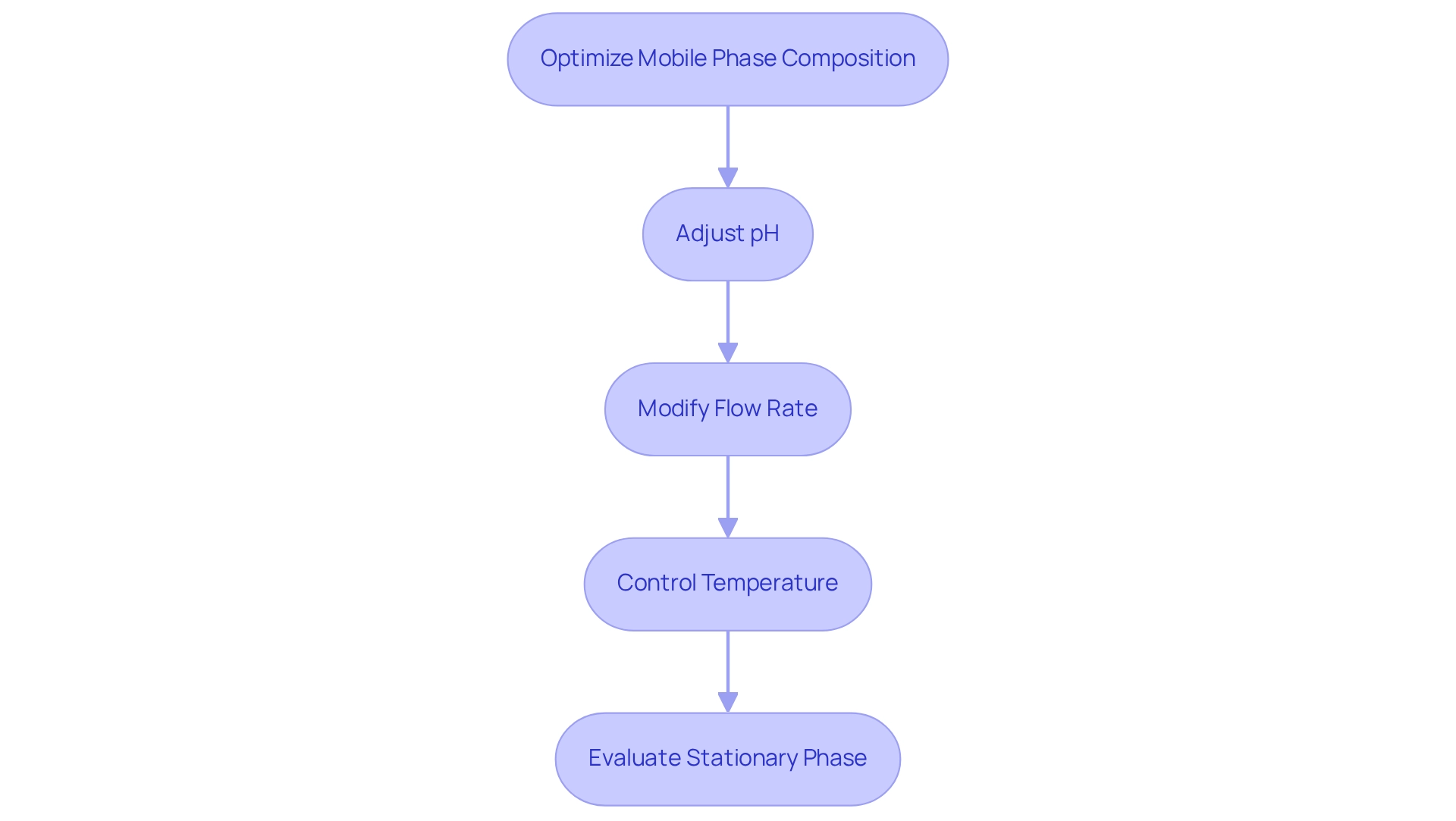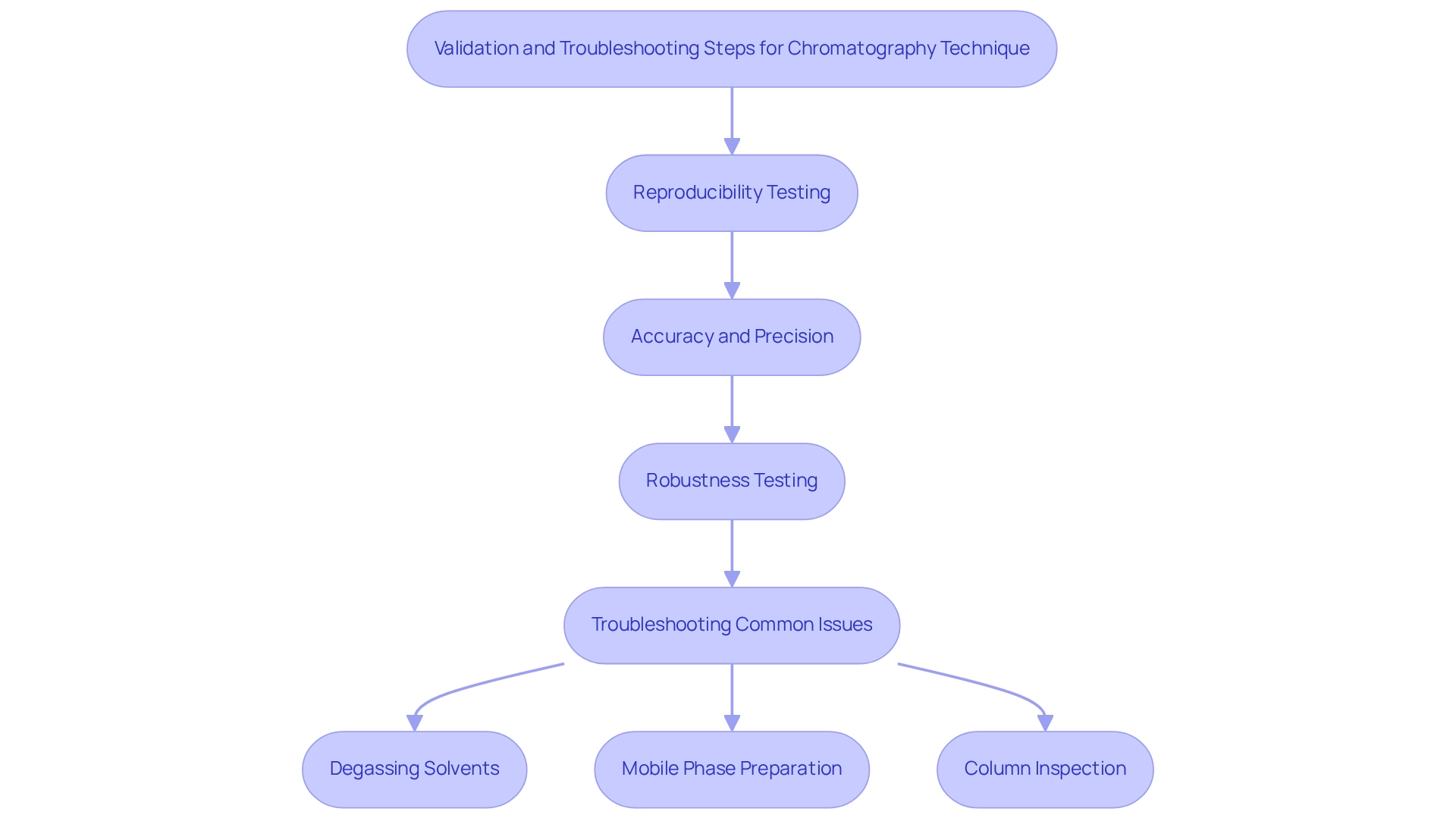Overview
This article delves into the optimization of High-Performance Liquid Chromatography (HPLC) reverse phase techniques, a critical endeavor for enhancing laboratory performance and reliability. By adjusting essential parameters—including mobile phase composition, pH, flow rate, and temperature—laboratories can significantly improve their analytical capabilities. Various studies provide compelling evidence that these adjustments lead to enhanced separation efficiency and reproducibility in results, underscoring the necessity of meticulous calibration in laboratory settings.
The importance of these optimizations cannot be overstated; they are foundational to achieving high-quality outcomes in analytical chemistry. As we explore the impact of each parameter, it becomes evident that even minor adjustments can yield substantial improvements in performance metrics. This article aims to equip laboratory professionals with the knowledge required to implement these changes effectively, thereby fostering a culture of excellence in analytical practices.
In conclusion, the optimization of HPLC techniques is not merely a technicality but a vital component of laboratory success. By prioritizing the adjustment of critical parameters, laboratories can enhance both the reliability and efficiency of their operations, ultimately leading to more accurate and reproducible results.
Introduction
In the field of analytical chemistry, High-Performance Liquid Chromatography (HPLC) is a cornerstone technique for the separation and quantification of complex mixtures. Notably, reverse phase chromatography has emerged as a prominent method due to its exceptional capacity to separate compounds based on hydrophobicity. This characteristic renders it indispensable across various applications, particularly in pharmaceuticals and environmental testing.
As laboratories increasingly prioritize precision and reliability, it is essential to comprehend the intricate parameters that influence HPLC performance. From optimizing mobile phase composition to validating methods for reproducibility, mastering HPLC requires a meticulous approach to method development and troubleshooting.
This article explores the fundamental aspects of HPLC and reverse phase chromatography, emphasizing key strategies for optimizing analytical methods and ensuring consistent results in diverse laboratory environments.
Understand HPLC and Reverse Phase Chromatography
High-Performance Liquid Chromatography (HPLC) stands as a pivotal analytical technique for the separation, identification, and quantification of components within complex mixtures. In reverse phase chromatography, the stationary medium is characterized as non-polar, while the mobile medium is polar. This arrangement facilitates the separation of compounds based on their hydrophobicity; compounds exhibiting heightened hydrophobic characteristics demonstrate stronger interactions with the stationary medium, resulting in delayed elution times. A thorough understanding of these principles is crucial for effectively enhancing chromatography techniques.
Key concepts include:
- Stationary Phase: Typically composed of silica particles coated with hydrophobic groups, enhancing the retention of hydrophobic compounds.
- Mobile Phase: Generally a mixture of water and organic solvents, such as methanol or acetonitrile, which influences the elution of compounds.
- Retention Time: The duration a compound takes to traverse the column, significantly influenced by its interaction with the stationary phase.
Recent advancements in HPLC reverse phase liquid chromatography techniques underscore the importance of procedural robustness, particularly under suboptimal conditions. A case study evaluating the robustness of analytical methods identified critical parameters such as temperature, flow rate, and solvent composition, which are vital for ensuring measurement reliability. Moreover, recent statistics reveal that percent recoveries for spiked seaweed samples ranged from 85% to 111%, demonstrating the efficiency of HPLC reverse phase in analytical chemistry, particularly in pharmaceutical applications where accuracy is paramount.
Furthermore, the integration of for the identification of parabens reflects the evolving landscape of liquid chromatography techniques, promoting sustainable practices in laboratory environments. By mastering these foundational concepts, laboratory professionals are empowered to make informed decisions during the optimization process, ultimately enhancing the performance and reliability of their analytical techniques. As Douglas Morisue Sartore aptly noted, 'These figures of merit indicate that the HPLC reverse phase technique paired with the US-Fe @rGO-DSPE method is appropriate for the determination of parabens in Antarctic samples,' underscoring the versatility and applicability of high-performance liquid chromatography across various analytical contexts.
Identify Key Parameters for Optimization
To optimize reverse phase HPLC, several key parameters must be considered:
- Mobile Phase Composition: The ratio of water to organic solvent is crucial, as it directly affects retention times and peak shapes. Adjusting this ratio can significantly enhance separation efficiency. Studies indicate that differences in retention time can be as minimal as 0.2% when optimized correctly. This research, funded by the Slovenian Research Agency (ARIS, Grant number P1–153), underscores its credibility.
- pH of the Mobile Phase: The pH influences the ionization state of analytes, impacting their retention and separation. Selecting an optimal pH is essential for maintaining analytes in their desired state. Laboratory supervisors have observed that even minor changes in pH can result in significant enhancements in procedure performance. As Suraj R. Chaudhari stated, "Thus, a new, precise, and accurate HPLC technique was developed and validated and can be used for regular analysis of apremilast."
- Flow Rate: The velocity of the mobile component through the column influences both resolution and analysis duration. A slower flow rate typically enhances resolution but extends analysis time, making it a critical factor in method optimization.
- Column Temperature: Increasing the temperature can lower viscosity and improve mass transfer, resulting in sharper peaks and reduced retention times. This adjustment is particularly beneficial for complex mixtures.
- Stationary Characteristics: The selection of stationary medium, such as C18 or C8, plays a significant role in selectivity and retention. Understanding the properties of different phases can guide the selection process for specific applications.
By thoroughly grasping and modifying these parameters, laboratories can significantly improve the performance of , resulting in more dependable and effective analyses. For instance, a stability study demonstrated that drug standards remained stable for up to 40 hours under optimized conditions, adhering to ICH guidelines. This underscores the significance of optimizing approaches in attaining reliable and precise outcomes. Furthermore, the accuracy of the developed technique was calculated using % relative standard deviation (RSD) from repeatability and intermediate precision studies, indicating the need for further investigation into the effects of methanol on HILIC separation. The study is cited in various formats, including MDPI, AMA, Chicago/Turabian, and APA styles, reflecting its significance in the field.
Adjust Method Parameters for Improved Performance
To enhance HPLC reverse phase performance, systematically adjusting key parameters is essential. Follow these steps to optimize your results:
- Optimize Mobile Phase Composition: Begin with a gradient elution approach, starting with a higher percentage of water and gradually increasing the organic solvent. This method allows for monitoring retention times and peak shapes, which aids in identifying the optimal balance for your specific analytes.
- Adjust pH: Experiment with various pH levels within the recommended range for your analytes. Utilizing a buffer can help maintain stability and ensure reproducibility, critical for consistent results.
- Modify Flow Rate: Start with the manufacturer’s recommended flow rates and incrementally decrease them. This adjustment can significantly impact resolution and analysis time, allowing for fine-tuning of the method.
- Control Temperature: Maintain a consistent column temperature, typically between 25°C and 40°C, depending on the analytes being analyzed. Employing a temperature-controlled column compartment is crucial for ensuring stability and reproducibility during runs. Notably, temperature can greatly influence the viscosity of solvents and, consequently, the separation efficiency in HPLC, as emphasized in a case study regarding the effect of temperature on HPLC outcomes.
- Evaluate Stationary Phase: If necessary, consider switching to a different stationary phase that may provide better selectivity for your analytes. This can lead to improved separation and enhanced analytical capabilities. A case study highlighting the essential importance of vial cap compatibility demonstrates how choosing the suitable vial cap can alleviate problems connected to sample integrity, thus improving the dependability of chromatographic results.
Recording all modifications and their impacts on results is essential for further enhancing your approach. Ongoing enhancement and commitment to optimal methods will guarantee effective execution of HPLC reverse phase techniques, ultimately improving laboratory results. As Kalvin Chen, Co-founder of Mastelf Technologies, states, "By following these steps, you can enhance while reducing downtime and frustrations." Furthermore, referencing credible sources can improve comprehension of mobile phase optimization and HPLC reverse phase in high-performance liquid chromatography.

Validate and Troubleshoot Your Optimized Method
To ensure the reliability of your refined chromatography technique, comprehensive validation is essential. This process not only confirms the technique's performance but also enhances reproducibility, a critical factor in pharmaceutical applications.
Validation Steps:
- Reproducibility Testing: Conduct multiple injections of the same sample to assess the consistency of retention times and peak areas. This step is crucial, as reproducibility is frequently quantified using the relative standard deviation (RSD), which should ideally remain below 2% for dependable results. The threshold of quantification is defined by various conventions as five, six, or ten standard deviations of the blank mean, providing a benchmark for evaluating reproducibility in HPLC procedures.
- Accuracy and Precision: Assess the accuracy of your method by utilizing standard solutions. Calculate the RSD to evaluate precision, ensuring your measurements closely align with the true analyte concentrations. As noted by a Six Sigma Practitioner, "The true power of RSD lies not just in its calculation, but in its interpretation and application," highlighting the importance of understanding RSD in performance evaluation.
- Robustness Testing: Introduce minor variations to procedural parameters, such as slight adjustments in pH or flow rate, to evaluate the robustness of your method. This testing helps identify how resilient your approach is to minor changes, which is vital for ensuring consistent outcomes across different laboratory conditions.
- Troubleshooting Common Issues: Address potential challenges that may arise during analysis:
- Ensure proper degassing of solvents to eliminate air bubbles that can disrupt flow.
- Verify the preparation of the mobile phase, ensuring it is filtered to remove particulates that could affect results.
- Examine the column for deterioration or contamination, as these factors can significantly influence performance.
By following these validation and troubleshooting steps, you can enhance the reliability and reproducibility of , ultimately leading to more accurate and consistent analytical outcomes in your laboratory. Furthermore, consider the concept of pooled RSD, which is valuable in multi-site studies for comparing process variability across different manufacturing locations, further underscoring the significance of reproducibility in pharmaceutical applications.

Conclusion
Mastering High-Performance Liquid Chromatography (HPLC) and reverse phase chromatography is essential for achieving reliable and precise analytical results across various fields, particularly in pharmaceuticals and environmental testing. A solid understanding of the fundamentals—including the roles of stationary and mobile phases, as well as key parameters such as mobile phase composition, pH, flow rate, and temperature—empowers laboratory professionals to optimize their methods effectively.
Systematically adjusting these parameters not only enhances the performance of HPLC methods but also ensures reproducibility and robustness, which are critical for consistent analytical outcomes. Validation and troubleshooting serve as vital steps in this process, confirming the reliability of optimized methods and identifying potential issues that may impact results.
In summary, the meticulous approach to method development and optimization discussed in this article highlights the significance of HPLC in analytical chemistry. By applying these strategies, laboratories can markedly improve the efficiency and accuracy of their analyses, ultimately contributing to advancements in research and industry applications. Embracing these best practices will not only enhance laboratory outcomes but also deepen the understanding of the complexities involved in high-performance liquid chromatography, paving the way for continuous improvement and innovation in analytical techniques.




